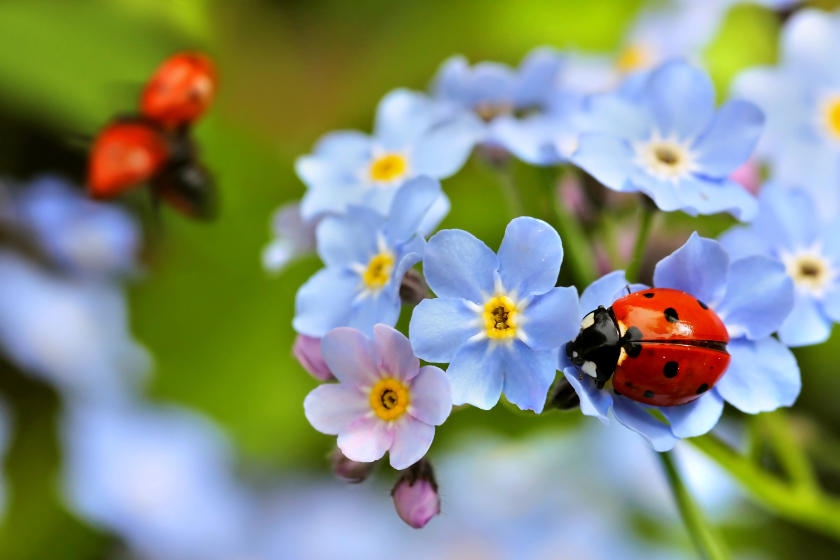One of the best ways to grow a bountiful and beautiful garden is to recreate the natural relationship between fauna and flora that exists in the wild. By growing plants that attract beneficial insects, you can keep your garden healthy, thriving and balanced by naturally controlling garden pests.
Which Bugs are Beneficial?
First, it helps to know which garden insects help or hurt the health of your plants. While there are a number of insects that can harm your plants by feeding on them, other insects can help control the populations of harmful bugs. Pollinators, or insects that pollinate plants, also are great additions to your garden’s ecosystem. Here are just a few of the beneficial garden guardians and caretakers.
-
- Ladybugs – Adult lady beetles and their larvae feed on aphids, tree lice and other insects that feed on your garden plants. Part of the reason ladybugs are considered “good luck” is based on their history of being good garden bugs that protect your plants.
- Ground Beetles – Ground beetles patrol the ground in and around your garden, feeding on slugs, snails, grubs, small worms and other insect larvae that feed on plants. They can grow up to 1” long, and usually have black or brown shells. Beetles like to lie in wait under bark, mulch and debris.
- Wasps – There are numerous species of wasps that are beneficial to gardens. Some are predatory, while others are parasitic, but both types can control common garden pests. They also pollinate, but not to the extent of honeybees. Parasitic wasps use harmful insects as incubators for their offspring, which means that more of these wasps may continue to live in your garden.
- Bees – Bees are highly beneficial pollinators, pollinating 80 percent of flowering crops — 1/3 of everything we eat. The most common types of bees in the U.S. are the honeybee and the bumblebee.
- Spiders – Though technically not insects, spiders do feed on many different kinds of insects, and if they are living in or near your garden, they will keep harmful insect populations in check.
- Assassin Bugs – These bugs get their name from the way they sneak up on their prey. They prey on flies, mosquitoes, caterpillars, thrips, spider mites, beetles, among others.
- Soldier Beetles – These beetles are about 1/2” long and resemble lightning bugs. They eat aphids, small caterpillars, and feed on many types of insect larvae.
- Tachinid Flies – These look similar to house flies but tend to stick around gardens and other areas full of plants. They prey on cutworms, caterpillars, grasshoppers, moths, sawflies and Japanese beetles.
- Lacewings – These are pale green flying insects about 3/8” long. Their larvae feed on aphids, caterpillars, mites and thrips.
Make Your Garden Appealing to Beneficial Insects
There are a few ways to bring beneficial insects to your garden. One of them is to grow plants that attract them or the bugs they prey on. The latter part shouldn’t be an issue — many garden plants are usually under siege by garden pests, such as aphids, Japanese beetles, slugs and snails, spider mites, caterpillars, grasshoppers and grubs. Search your garden for insects or for signs they have been feeding on your plants. Use a magnifying glass to help you. While some of the plants in your garden may already be nectar- or pollen-producing, adding more of these types of plants to your garden plot will attract beneficial pollinators such as bees and also other insects that like pollen and nectar, such as lady bugs and tachinid flies. Once these beneficial insect friends arrive in your garden, they will hopefully set up residence there and become a part of your backyard ecosystem.
Helpful Tips
Planting a variety of plants ensures more beneficial insect activity. Many of these insects feed on pollen and nectar as a substitute food supply when prey is scarce.
Plant both annuals and perennials and surround your garden with native grasses, ground cover, shrubs and trees.
Add plants that are native to your region. Plants that are accustomed to growing in your type of soil and in your area’s weather patterns will grow best naturally. Native beneficial insects will also be more attracted to your garden, as well as butterflies and birds, which also help control harmful insect populations.
Gardens with clover, wild carrots, dill, parsley, alyssum, yarrow, broccoli, goldenrod and sunflowers will attract beneficial insects — as will mint, daisy, anise, blue lace, coriander, fennel and mustard. These are just a few of the potential options. If you have other plants in mind and aren’t sure if they’ll attract beneficial insects, ask someone for assistance at your local True Value® hardware store.
Set up a “bug bath.” If there are no water sources adjacent to your garden, place a small container in the garden, such as a shallow dish, and fill it with a few stones and pebbles and a little bit of water for insects. Many insects may congregate here, so it can be attractive to the beneficial insects and also to the bugs they may prey on.
Adding mulch to your garden beds gives ground beetles and spiders places to lie in wait for prey. Spiders, in particular, do well in straw or hay mulch. Straw mulch can also deter some harmful beetles looking to lunch on your plants.
Helpful Tip
If you don’t feel the beneficial insect population is robust enough, you can purchase insects, such as ladybugs, from an insect farm and introduce them to your garden. Follow the insect farm instructions carefully to improve your chances of starting a healthy population.
Good job! Your garden should soon be populated by the beneficial insects it needs to prosper.
Project Shopping List
Here’s what you’ll need to complete this project successfully.










